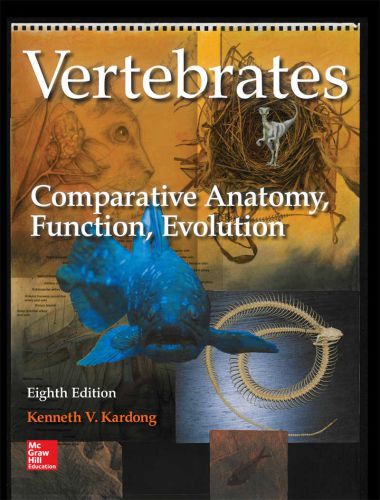Vertebrates – Comparative Anatomy, Function, Evolution 8th Edition, This one-semester text is designed for an upper-level majors course. Vertebrates features a unique emphasis on function and evolution of vertebrates, complete anatomical detail, and excellent pedagogy. Vertebrate groups are organized phylogenetically, and their systems discussed within such a context. Morphology is foremost, but the author has developed and integrated an understanding of function and evolution into the discussion of anatomy of the various systems.

If you are a student coming to the study of vertebrates for the first time, several introductory remarks may be helpful, especially on how this textbook will support your work. First, the discipline of vertebrate biology is diverse and inclusive. It brings together themes from molecular biology, genes and genomes, evolution and embryology, biomechanics and experimental physiology, and it incorporates continuing and astonishing new fossils into the vertebrate story. Much of what you have met in earlier courses you will meet again here in an integrated way.
Second, to unify these themes, I have again written and revised this eighth edition within the unifying framework of form, function, and evolution. The first few chapters set this up, and the subsequent chapters treat vertebrates system by system. You may notice that each of these subsequent chapters begins with a discussion of morphology, followed by a discussion of function and evolution. Each chapter is therefore self-contained—form, function, evolution.
For faculty who have used this textbook before, you will find it retains a familiar and inviting organization with the science updated and the student support enhanced. For those coming to this textbook for the first time, you will notice that the morphology receives generous treatment within a phylogenetic context. But today we expect our students to develop academic and professional skills beyond just facility with anatomical terminology. In general, we expect our students to develop skills in critical thinking and a facility with scientific concepts. Each of us will find our own way of composing a course in vertebrate morphology that serves such course objectives.
This textbook was written to support such course objectives as individual instructors build their courses. It is flexible. You can mix and match, change order to suit your course, and give emphasis to those systems that most suit the organization of your course. Because each chapter integrates form, function, and evolution pertinent to that system, each chapter is coherent within itself. Where information or concepts are treated in greater detail outside a particular chapter, they are cross referenced to help guide the student and clarify the discussion. Although discussed in earlier editions, let me repeat the specific strategy built into this textbook to improve student success and to help them develop skills in critical thinking and conceptual understanding.
Password: pdflibrary.net
